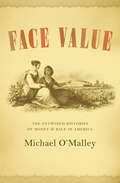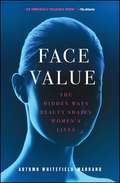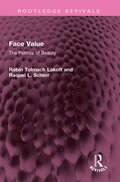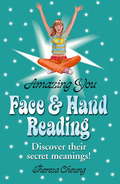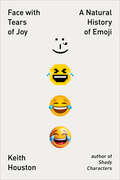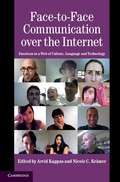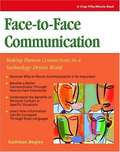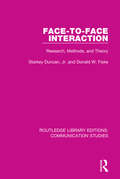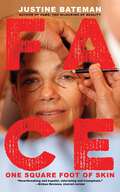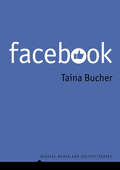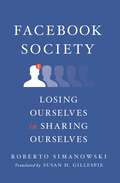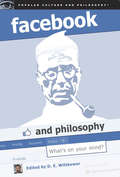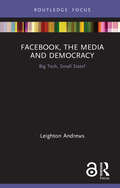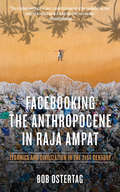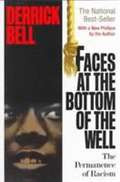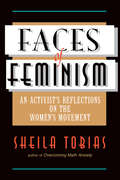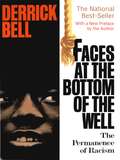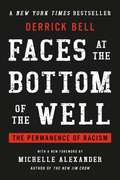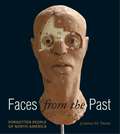- Table View
- List View
Face Value: The Entwined Histories of Money and Race in America
by Michael O'MalleyThe cultural historian and author of Keep Watching analyses American ideas about race, money, identity, and their surprising connections through history. From colonial history to the present, Americans have passionately, even violently, debated the nature and of money. Is it a symbol of the value of human work and creativity, or a symbol of some natural, intrinsic value? In Face Value, Michael O&’Malley provides a penetrating historical analysis of American thinking about money and the ways that this ambivalence intertwines with race. Like race, money is bound up in questions of identity and worth, each a kind of shorthand for the different values of two similar things. O&’Malley illuminates how these two socially constructed hierarchies are deeply rooted in American anxieties about authenticity and difference. In this compelling work of cultural history, O&’Malley interprets a wide array of historical sources to evaluate competing ideas about monetary value and social distinctions. More than just a history, Face Value offers a new way of thinking about the present culture of coded racism, gold fetishism, and economic uncertainty. &“This is a &‘big idea&’ book that no one but Michael O&’Malley could even have thought of—much less pulled off with such nuance and clarity.&”—Scott A. Sandage, author of Born Losers
Face Value: The Hidden Ways Beauty Shapes Women's Lives
by Autumn Whitefield-MadranoA thought-provoking examination of how we think and talk about beauty today--and the unexpected and often positive ways that beauty shapes our lives.For decades, we've discussed our insecurities in the face of idealized, retouched, impossibly perfect images. We've worried primping and preening are a distraction and a trap. But have we focused too much on beauty's negative influence? In Face Value, journalist Autumn Whitefield-Madrano thoughtfully examines the relationship between appearance and science, social media, sex, friendship, language, and advertising to show how beauty actually affects us day to day. Through meticulous research and interviews with dozens of women across all walks of life, she reveals surprising findings, like that wearing makeup can actually relax you, that you can convince people you're better looking just by tweaking your personality, and the ways beauty can be a powerful tool of connection among women. Equal parts social commentary, cultural analysis, careful investigation, and powerful personal anecdotes, Face Value is provocative and empowering--and a great conversation starter for women everywhere.
Face Value: The Politics of Beauty (Routledge Revivals)
by Robin Lakoff Raquel ScherrFirst published in 1984, Face Value confronts the pervasive power of beauty through art and literature, as well as interviews with men and women with varying perspectives on the subject. The topics covered range widely: the history of beauty from the Greeks to the present; the pathology of beauty: how women have been willing to harm themselves, mentally and physically, to achieve ‘beauty’; the language we use to speak of beauty, and its implications; our attitudes towards beauty, as examined by psychologists; beauty and ethnic identity; men and beauty. The authors present in fact a redefinition of beauty, enabling both women and men to enjoy it in themselves and in others, while discarding the sex-role stereotypes that have governed the definition of beauty in the past. With a new preface that explores the gaps created by time in the book’s discourse, this book will be of interest to students of linguistics, gender studies, women’s studies, cultural studies, sociology and anthropology.
Face and Hand Reading (Amazing You #24)
by Theresa Cheung"I've always hated my nose. The way it looks, and the fact that it's so big. When I was little I'd do drawings of smiling faces with no noses. My parents and teachers would always remind me to draw the nose, but I never did. The way I see my nose has changed since I started face reading. If only I'd known sooner that having a long nose is pretty cool." - Sarah, 12You can learn the most amazing things by simply using your face and hands (and a little help from this book). You see faces everyday but do you really look at them? Face reading helps you to analyse every feature, line and shape and work out what they say about your personality, relationships and future destiny. Hand reading, or palmistry, is another brilliant way to find out all about you and your friends and family. By looking at your whole hand, fingers and thumbs, and lines on your palms you'll see just how useful and informative hand reading can be in your everyday life. Face and Hand Reading shows you how you can change your life by discovering just how incredible and unique you are. It is part of our stunning new Mind Body Spirit series for teenage girls - Amazing You.
Face to Face with Emotions in Health and Social Care
by Benjamin GrayThis book draws from the everyday experiences as well as the harsh realities confronting behavioral care providers on the frontline. The book recounts the stories and sometimes disturbing emotions of people whose lives have undergone sudden change or even drastic trauma; people whose feelings of comfort and safety have been shattered by exposure to illness, abuse, death and bereavement. The perspectives and experiences of nurses, social care staff, patients, children and families are at the core of understanding the importance, challenges and therapeutic vitality of emotions. The 55 individuals on the frontline who took part in the interviews on which this study is based discuss the emotions associated with care in mental health, pediatric oncology, AIDS/HIV, as well as child protection and abuse, racism, refugee exile, poverty, and social exclusion. Their bravery, openness, and ability to communicate and share their emotions make this book possible.
Face with Tears of Joy: A Natural History of Emoji
by Keith HoustonA vibrant exploration of the world’s newest language—where it came from, how it works, and where it’s going. We are surrounded by emoji. They appear in politics, movies, drug deals, our sex lives, and more. But emoji’s impact has never been explored in full. In this rollicking tech and pop culture history, Keith Houston follows emoji from its birth in 1990s Japan, traces its Western explosion in the 2000s, and considers emoji’s ever-expanding lexicon. Named for the world’s most popular pictogram, Face with Tears of Joy tells the whole story of emoji for the first time.
Face-to-Face Communication over the Internet
by Arvid Kappas Nicole C. KrämerSocial platforms such as MySpace, Facebook and Twitter have rekindled the initial excitement of cyberspace. Text-based, computer-mediated communication has been enriched with face-to-face communication such as Skype, as users move from desktops to laptops with integrated cameras and related hardware. Age, gender and culture barriers seem to have crumbled and disappeared as the user base widens dramatically. Other than simple statistics relating to e-mail usage, chatrooms and blog subscriptions, we know surprisingly little about the rapid changes taking place. This book assembles leading researchers on nonverbal communication, emotion, cognition and computer science to summarize what we know about the processes relevant to face-to-face communication as it pertains to telecommunication, including video-conferencing. The authors take stock of what has been learned regarding how people communicate, in person or over distance, and set the foundations for solid research helping to understand the issues, implications and possibilities that lie ahead.
Face-to-Face Communication: Making Human Connections in a Technology-Driven World
by Kathleen A. BegleyEven as technology has allowed us to connect with an ever-expanding global network through the click of a mouse, face-to-face communication is still as important as ever. Improving one's in-person communication may seem nonessential and downright quaint in this computerized age, yet many workplace situations, often those involving conflict, feelings, or other sensitive issues, still demand human contact. FACE-TO-FACE COMMUNICATION explores why personal contact remains the most powerful type of human interaction and what readers can do to improve their skills to become excellent communicators.
Face-to-Face Interaction: Research, Methods, and Theory (Routledge Library Editions: Communication Studies #3)
by Donald W. Fiske Starkey DuncanOriginally published in 1977. This book focuses on how to do research in the area of face-to-face interaction when studying human social conduct. It covers the methods of data collection and analysis and looks at the efficiency of these. It secondarily considers a model for conceptualising such interactions, drawing together several social science components, especially linguistics, based on the idea that there is an organisational structure at work just as with grammar for language. Overall the book proposes a general conceptual framework for guiding empirical investigation, with emphasis on simultaneous study of a number of acts viewed within each other’s contexts. This is an excellent resource for study on non-verbal communications, describing specific studies as well as offering the clear overview and model for research.
Face-veiled Women in Contemporary Indonesia (ASAA Women in Asia Series)
by Eva F. NisaFace veiling is relatively new in Indonesia. It is often stereotyped as a sign of extremism and the growing Arabisation of Indonesian Muslims. It is also perceived as a symbol that demonstrates a lack of female agency. However, increasing numbers of women are choosing to wear the cadar (the full face veil). This book provides an ethnographic study of these women: why they choose to wear the cadar, embody strict religious disciplinary practices and the consequences of that choice. The women in this book belong to two Islamic revivalist movements: various Salafi groups and the Tablīghī Jamāʿat. Indonesia has constantly witnessed transformations in the meanings and practices of Islam, and this book demonstrates that women are key actors in this process. Nisa demonstrates that contrary to stereotypes, the women in this study have an agency which is expressed through their chosen docility and obedience.
Face: One Square Foot Of Skin
by Justine BatemanWriter/director/producer Justine Bateman examines the aggressive ways that society reacts to the aging of women's faces. "Face . . . is filled with fictional vignettes that examine real-life societal attitudes and internal fears that have caused a negative perspective on women's faces as they age." —TODAY Show, a Best Book of 2021 "There is nothing wrong with your face. At least, that's what Justine Bateman wants you to realize. Her new book, Face: One Square Foot of Skin, is a collection of fictional short stories told from the perspectives of women of all ages and professions; with it, she aims to correct the popular idea that you need to stop what you're doing and start staving off any signs of aging in the face." —W "Combining the author's intensely personal stories with relevant examples from the culture at large, the book is heartbreaking and hopeful, infuriating and triumphant." —Kirkus Reviews, starred review Face is a book of fictional vignettes that examines the fear and vestigial evolutionary habits that have caused women and men to cultivate the imagined reality that older women's faces are unattractive, undesirable, and something to be "fixed." Based on "older face" experiences of the author, Justine Bateman, and those of dozens of women and men she interviewed, the book presents the reader with the many root causes for society's often negative attitudes toward women's older faces. In doing so, Bateman rejects those ingrained assumptions about the necessity of fixing older women's faces, suggesting that we move on from judging someone's worth based on the condition of her face. With impassioned prose and a laser-sharp eye, Bateman argues that a woman's confidence should grow as she ages, not be destroyed by society's misled attitude about that one square foot of skin.
Facebook (Digital Media and Society #104)
by Taina BucherFacebook has fundamentally changed how the world connects. No other company has played a greater role in the history of social networking online. Yet Facebook is no longer simply a social networking site or social media platform. Facebook is Facebook. Taina Bucher shows how Facebook has become an idea of its own: something that cannot be fully described using broader categories. Facebook has become so commonplace that most people have a conception of what it is, yet it increasingly defies categorization. If we want to understand Facebook's power in contemporary society and culture, Bucher argues, we need to start by challenging our widespread conception of what Facebook is. Tracing the development and evolution of Facebook as a social networking site, platform, infrastructure and advertising company, she invites readers to consider Facebook anew. Contrary to the belief that nobody uses Facebook anymore, Facebook has never been more powerful. This timely book is important reading for students and scholars of media and communication, as well as anyone seeking to understand the Facebook phenomenon.
Facebook Nation
by Newton LeePresident Barack Obama, in his 2011 State of the Union Address, called America "the nation of Edison and the Wright brothers" and "of Google and Facebook." U.S. Chief Information Officer, Steven VanRoekel, said that America has become a "Facebook nation" that demands increased transparency and interactivity from the federal government. Facebook as a nation in 2012 would be the third largest country in the world with over 900 million citizens, after China and India. This book portrays the social media ecosystem as a world of increasing Total Information Awareness, which is essentially a civilian version of the controversial Total Information Awareness program unveiled in 2002 by the Defense Advanced Research Projects Agency (DARPA) at the U.S. Department of Defense. Back in the 60's, DARPA initiated and funded the research and development of Advanced Research Projects Agency Network (ARPANET) that went online in 1969. The success of ARPANET gave rise to the global commercial Internet in the 90's and the new generation of Fortune 500 companies today including Amazon.com, Google, eBay, and Yahoo!. As if life comes full circle in the 21st century, private businesses and the ubiquity of social networks such as Facebook, Google+, Twitter, and YouTube are creating the technologies and infrastructures necessary for the DARPA-proposed Total Information Awareness program. WikiLeaks founder Julian Assange called Facebook "the most appalling spying machine that has ever been invented." Indeed, military and civilian technologies have interwoven into every fabric of our society, as Facebook co-founder and CEO Mark Zuckerberg said, "We exist at the intersection of technology and social issues." This book offers discourse and practical advice on the privacy issue in the age of big data, the rise of Facebook nation, and Total Information Awareness. Opening with President Ronald Reagan's 1984 National Security Decision Directive and ending with George Orwell's novel 1984, the author takes us on a roller-coaster ride through Facebook's botched IPO, Carrier IQ, Kony 2012, SOPA/PIPA blackout, cyber bullying, crime fighting, and a host of other timely issues facing our Facebook nation. Social media strategists, information architects, social scientists, policymakers, and academic scholars in the Program in Science, Technology, and Society (STS) will find this book a valuable asset.
Facebook Society: Losing Ourselves in Sharing Ourselves
by Roberto SimanowskiFacebook claims that it is building a “global community.” Whether this sounds utopian, dystopian, or simply self-promotional, there is no denying that social-media platforms have altered social interaction, political life, and outlooks on the world, even for people who do not regularly use them. In this book, Roberto Simanowski takes Facebook as a starting point to investigate our social-media society—and its insidious consequences for our concept of the self.Simanowski contends that while they are often denounced as outlets for narcissism and self-branding, social networks and the practices they cultivate in fact remake the self in their image. Sharing is the outsourcing of one’s experiences, encouraging unreflective self-narration rather than conscious self-determination. Instead of experiencing the present, we are stuck ceaselessly documenting and archiving it. We let our lives become episodic autobiographies whose real author is the algorithm lurking behind the interface. As we go about accumulating more material for the platform to arrange for us, our sense of self becomes diminished—and Facebook shapes a subject who no longer minds. Social-media companies’ relentless pursuit of personal data for advertising purposes presents users with increasingly targeted, customized information, attenuating cultural memory and fracturing collective identity. Presenting a creative, philosophically informed perspective that speaks candidly to a shared reality, Facebook Society asks us to come to terms with the networked world for our own sake and for all those with whom we share it.
Facebook and Philosophy
by D. E. WittkowerFacebook and Philosophy is an entertaining, multi-faceted exploration of what Facebook means for us and for our relationships. With discussions ranging from the nature of friendship and its relationship to "friending," to the (debatable) efficacy of "online activism," this book is the most extensive and systematic attempt to understand Facebook yet. And with plenty of new perspectives on Twitter and Web 2.0 along the way, this fun, thought-provoking book is a serious and significant contribution for anyone working with social media, whether in academia, journalism, public relations, activism, or business. Exploring far-reaching questions - Can our interactions on Facebook help us care about each other more? Does Facebook signal the death of privacy, or (perhaps worse yet) the death of our desire for privacy? - Facebook and Philosophy is vital reading for anyone involved in social networks today.
Facebook and the: How the Social Network Reshaped the Legal Framework (Law, Governance and Technology Series #48)
by Philippe JougleuxThe past two decades have seen a radical change in the online landscape with the emergence of GAFAM (Google, Amazon, Facebook, Apple and Microsoft). Facebook, specifically, has acquired a unique monopoly position among social media, and is part of the digital lives of billions of users. A mutual influence between Facebook and the legal framework has gradually emerged, as EU legislators and judges are on the one hand forced to accept the reality of new, widespread behaviors and practices and on the other have constructed a legal framework that imposes limits and rules on the use of the social network.This book offers a unique perspective on this relationship, exploring the various activities and services proposed by Facebook and discussing the attendant legal issues. Accordingly, questions concerning the GDPR, its principles, rights and obligations are in the center of the discussions. However, the book does not limit its scope to data protection: Facebook has also greatly contributed to a liberalization and democratization of speech. In accordance, the classic principles of media law must be revisited, adapted or suitably enforced on the platform. Intellectual property law governs what is owned and by whom, no matter whether raw data or informational goods are concerned. Frameworks on hate speech and fake news are the result of coregulation principles of governance, whereas defamation jurisprudence continues to evolve, considering the consequences of merely “liking” certain content. The economic model of advertising is also governed by strict rules. Above all, Facebook is currently caught in a dilemma of substantial interest for society as a whole: is it a neutral online intermediary, i.e., merely a passive player on the Internet, or is it transforming against its will into an editorial service? In conclusion, the book has a dual purpose. First, it proposes a global and practical approach to the EU legal framework on Facebook. Second, it explores the current limits and the ongoing transformation of EU Internet law as it steadily adapts to life in the new digital world.
Facebook, the Media and Democracy: Big Tech, Small State? (Disruptions)
by Leighton AndrewsFacebook, the Media and Democracy: Big Tech, Small State? examines Facebook Inc. and the impact that it has had and continues to have on the media and democracy around the world. Drawing on interviews with Facebook users of different kinds and dialogue with politicians, regulators, civil society and media commentators, as well as detailed documentary scrutiny of legislative and regulatory proposals and Facebook’s corporate statements, the book presents a comprehensive but clear overview of the current debate around Facebook, and the global debate on the regulation of social media in the era of ‘surveillance capitalism.’ Chapters examine the business and growing institutional power of Facebook as it has unfolded over the fifteen years since its creation, the benefits and meanings that it has provided for its users, its disruptive challenge to the contemporary media environment, its shaping of conversations, and the emerging calls for its further regulation. It considers Facebook’s alleged role in the rise of democratic movements around the world as well as its suggested role in the election of Donald Trump and the UK vote to leave the European Union. The book argues that Facebook, in some shape or form, is likely to be with us into the foreseeable future: how we address the societal challenges that it provokes, and the economic system that underpins it, on a global basis, will define how human societies demonstrate their capacity to protect and enhance democracy and ensure that no corporation can set itself above democratic institutions.
Facebook: The Inside Story
by Steven LevyHe has had unprecedented access to Mark Zuckerberg and Sheryl Sandberg for three years. And now renowned tech writer Steven Levy delivers the definitive history of one of America&’s most powerful and controversial companies: Facebook.In his sophomore year of college, Mark Zuckerberg created a simple website to serve as a campus social network. The site caught on like wildfire, and soon students nationwide were on Facebook. Today, Facebook is nearly unrecognizable from Zuckerberg&’s first, modest iteration. It has grown into a tech giant, the largest social media platform and one of the most gargantuan companies in the world, with a valuation of more than $576 billion and almost 3 billion users, including those on its fully owned subsidiaries, Instagram and WhatsApp. There is no denying the power and omnipresence of Facebook in American daily life. And in light of recent controversies surrounding election-influencing &“fake news&” accounts, the handling of its users&’ personal data, and growing discontent with the actions of its founder and CEO, never has the company been more central to the national conversation. Based on hundreds of interviews inside and outside the company, Levy&’s sweeping narrative digs deep into the whole story of the company that has changed the world and reaped the consequences.
Facebooking the Anthropocene in Raja Ampat: Technics and Civilization in the 21st Century (KAIROS)
by Bob Ostertag Robert OstertagFacebooking the Anthropocene in Raja Ampat is a deeply intimate look at the cataclysmic shifts between humans, technology, and the so-called natural world. Despite the breakneck pace of both technological advance and environmental collapse, Bob Ostertag explores how we ourselves are changing as fast as the world around us—from how we make music, to how we have sex, to what we do to survive, and who we imagine ourselves to be. And though the environmental crisis terrifies and technology overwhelms, Ostertag finds enough creativity, compassion, and humor in our evolving behavior to keep us laughing and inspired as the world we are building overtakes the world we found. A true polymath who covered the wars in Central America during the 1980s and then published more than 20 CDs of music, 5 books on startlingly eclectic subjects, and a feature film, Ostertag fuses his travels as a touring musician with his journalist's eye for detail and the long view of a historian. Wander the world both physical and intellectual with him. Watch Buddhist monks take selfies while meditating. Ponder artificial intelligence with street kids in Java. Talk sex with porn stars who have never in their lives had sex off camera. Watch DJs who make millions of dollars pretend to turn knobs in front of crowds of thousands. Play World of Warcraft on remote Asia islands with indigenous people. Shiver with families huddling through the stinging Detroit winter without heat or electricity. Meet Spice Islanders who have never seen flushing toilets yet have gay hookup apps on their smartphones. Our best writers have struggled with how to address the catastrophes of our time without looking away. Ostertag succeeds where others have failed, with the moral acuity of Susan Sontag, the technological savvy of Lewis Mumford, and the biting humor of Jonathan Swift.
Faces At the Bottom of the Well: The Permanence of Racism
by Derrick A. BellThe noted civil rights activist uses allegory and historical example to present a radical vision of the persistence of racism in America. These essays shed light on some of the most perplexing and vexing issues of our day: affirmative action, the disparity between civil rights law and reality, the "racist outbursts" of some black leaders, the temptation toward violent retaliation, and much more.
Faces Of Feminism: An Activist's Reflections On The Women's Movement (Foundations Of Social Inquiry Ser.)
by Sheila TobiasAs one of the main players in the second wave of feminism, Sheila Tobias returns to Kate Millets central tenet, sexual politics, and argues that it can still unite progressive men and women around a common set of goals. Providing a map of a complex terrain, Tobias details generations of issues, each more radical and therefore harder to tackle than the ones before. She sets the story in two contexts: feminisms own evolving strategies and Americas political landscape. Even though her passion for feminism remains, she is not unwilling to critique the sisterhood and herself for failing to see, for example, that not every woman would be a feminist nor every man an enemy. In the heady first years, feminists forgot that deeper even than gender is the liberal/conservative divide in American politics. }As one of the main players in the second wave of feminism, Sheila Tobias returns to Kate Millets central tenet, sexual politics, and argues that it can still unite progressive men and women around a common set of goals. Providing a map of a complex terrain, Tobias details generations of issues, each more radical and therefore harder to tackle than the ones before. She sets the story in two contexts: feminisms own evolving strategies and Americas political landscape. Even though her passion for feminism remains, she is not unwilling to critique the sisterhood and herself for failing to see, for example, that not every woman would be a feminist nor every man an enemy. In the heady first years, feminists forgot that deeper even than gender is the liberal/conservative divide in American politics.From the origins of the movement through feminist theory and new scholarship on women, Tobias traces the political history of the second wave and its comeuppance at the hands of Phyllis Schaflys StopERAcoincidental with the nations careering toward the Right. Somehow, feminism survived the 1980s, but by having to fight brush fires throughout the Reagan-Bush presidencies, the movement lost some of its breadth and much of its taste for the mainstream. Because of her activism and her feeling for the period she chronicles, Tobias is at once inside and outside the issues of sexual preference, pornography, the draft, the Mommy Track, comparable worth, affirmative action, reproductive rights, and the challenges of equality versus difference. }
Faces and Masks: Genesis, Faces And Masks, And Century Of The Wind (Memory of Fire #2)
by Eduardo Galeano&“A book as fascinating as the history it relates . . . Galeano is a satirist, realist, and historian.&” —Los Angeles TimesFor centuries, Europe&’s imperial powers brutally exploited the peoples and resources of the New World. While soldiers of fortune marched across continents in search of El Dorado, white settlers established plantations and trading posts along the coasts, altering the land and bringing disease and slavery with them. In the midst of a bloody collision of civilizations, the West has birthed new societies out of the old.In the second book of his Memory of Fire trilogy, Eduardo Galeano forges a new understanding of the Americas, history retold from a diverse collection of viewpoints. Spanning the end of empire and the age of revolutions, Faces and Masks brilliantly collects the strands of the past into an iridescent work of literature.
Faces at the Bottom of the Well
by Derrick BellThe noted civil rights activist uses allegory and historical example to present a radical vision of the persistence of racism in America. These essays shed light on some of the most perplexing and vexing issues of our day: affirmative action, the disparity between civil rights law and reality, the "racist outbursts" of some black leaders, the temptation toward violent retaliation, and much more.
Faces at the Bottom of the Well: The Permanence of Racism
by Michelle Alexander Derrick BellThe classic work on American racism and the struggle for racial justiceIn Faces at the Bottom of the Well, civil rights activist and legal scholar Derrick Bell uses allegory and historical example to argue that racism is an integral and permanent part of American society. African American struggles for equality are doomed to fail so long as the majority of whites do not see their own well-being threatened by the status quo. Bell calls on African Americans to face up to this unhappy truth and abandon a misplaced faith in inevitable progress. Only then will blacks, and those whites who join with them, be in a position to create viable strategies to alleviate the burdens of racism. "Freed of the stifling rigidity of relying unthinkingly on the slogan 'we shall overcome,'" he writes, "we are impelled both to live each day more fully and to examine critically the actual effectiveness of traditional civil rights remedies."With a new foreword by Michelle Alexander, Faces at the Bottom of the Well is urgent and essential reading on the problem of racism in America.
Faces from the Past: Forgotten People of North America
by James M. DeemWhen skeletons from centuries ago are discovered, scientists want to study them to discover information about the lives , deaths , time and place in history of these people so that the nameless, unknown people can be brought back to life, remembered, and honoured.
